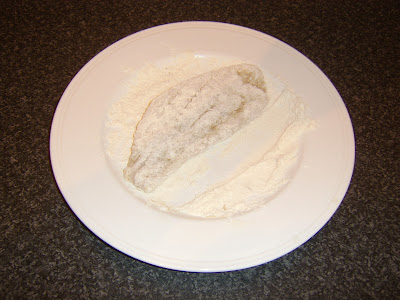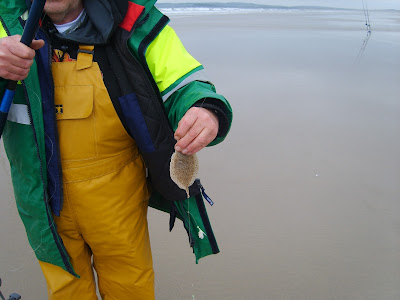 |
| Ling fillets shallow fried in fresh breadcrumbs and served with homemade chips |
A fish supper in Scotland usually consists of a fillet of haddock, deep fried in a simple flour and water batter and served with chips. A special fish supper is usually where the fish is instead fried in a breadcrumbs substitute. This fish supper sees ling fillets shallow fried in fresh breadcrumbs before being served with some crisp and crunchy homemade chips. A standard breadcrumbs substitute can of course be used if you wish but fresh breadcrumbs really do make a big difference.
 |
| Freshly caught ling of just over 5lb in weight and 38 inches in length |
The ling pictured above was caught from a boat on Loch Etive and - weighing in at just over 5 pounds - it measured 38 inches from snout to tail. It is easily possible to get around six decent ling meals from a fish of this size, so the next time you go ling fishing, consider keeping one for the pot. It truly is delicious. For more ling recipes and a step by step guide to filleting ling, visit the site linked to immediately below:
How to Cook Ling
Ingredients per Special Ling Supper
2 6" pieces of ling fillet
2 outside slices of bread (ideally a couple of days old)
1 medium egg
Salt and white pepper
Olive oil for frying
 |
| Removing the skin from a ling fillet |
Directions
The ling fillets in this instance had not already been skinned. Skinning them is not difficult, however - provided you have a proper filleting knife! - and only takes seconds.
Lay the fillet skin side down on a chopping board. Pinch the left edge (if you are right handed) and make an angled cut away from but as close to your fingers as you can, down to but not through the skin. Gently pulling the skin away from the knife, twist the knife until it is horizontal and cut through the flesh, over the skin, to remove.
 |
| Skin is removed from the first ling fillet |
Scatter the breadcrumbs in an even layer on a plate. Break the egg in to a small flat-bottomed bowl, season it with salt and pepper and lightly beat.
 |
| Fresh breadcrumbs and beaten egg for coating ling fillets |
Bring a little oil up to a moderate heat in a non-stick frying pan. Dip each fillet in the egg and pat it on both sides in the breadcrumbs. Repeat this process in each instance before laying the fillets gently in the pan. Fry for three or four minutes each side until the breadcrumbs are crisp and golden.
 |
| Pan frying the ling fillets in breadcrumbs |
Lift the fillets to a plate with a spatula or fish slice and arrange the chips alongside. A lemon wedge - and perhaps a sprig of parsley - serve as an optional garnish.
 |
| Crispy coated ling fillets are served with homemade chips |
The flesh of the ling is meaty, just like cod or haddock, and should be perfectly white if the fish is fresh.
 |
| The flesh of cooked ling fillets is pristinely white |














































